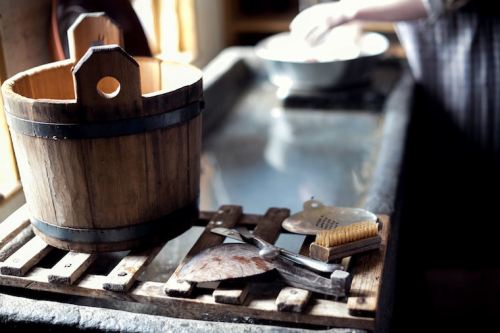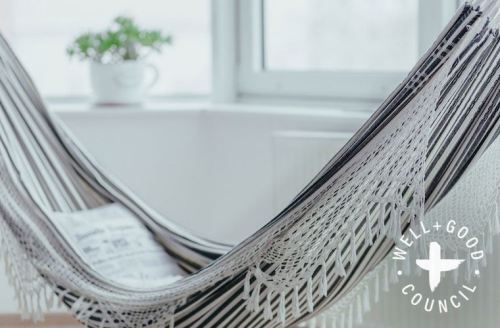Our editors independently select these products. Making a purchase through our links may earn Well+Good a commission
You fill your home with crystals, gorgeous plants, and dreamy decor elements like statement walls and shibori sheets, all in an effort to turn it into a high-vibe sanctuary worthy of your inner goddess. But if you really want to double down on the domestic–bliss factor, consider detoxing your space, says clean-living guru Sophia Gushée. Here, the Well+Good Council member and toxic-exposure expert explains why it’s so important and offers some super-simple advice on how to do it.
After nearly 10 years of research on how families can avoid unnecessary toxic exposures, I noticed a recurring strategy: Go back to basics.
Old-fashioned traditions that’ll detox your home include: Banning shoes in the home, opening your windows when outdoor air quality is good, washing your hands before you eat, and fixing more home-cooked meals. While these practices have been around since pre-industrial times, they’ve fallen to the sidelines amid our fast-paced, modern lives. And, since people tend to spend 90 percent of their time indoors, detoxing your home is arguably more important now than ever.
Since people tend to spend 90 percent of their time indoors, detoxing your home is important.
These strategies can have a high impact because the toxic chemicals that create our household products don’t stay in the products—they also get released into our air, dust, hands, food, and drinks. For example, indoor air tends to be two to five times more polluted than outdoor air—even in the most industrialized cities.
Furthermore, dozens of toxic chemicals (like pesticides, heavy metals, and chemical flame retardants) have been found in house dust across the country. Our hands then sweep these chemicals from surface areas, furniture, and clothing.
For anyone looking to get started on a home detox, below are 10 simple, relatively inexpensive things you can do that’ll make a big difference.

Detox your diet
Diet is a major source of our toxic exposures. To start eliminating harmful chemicals from yours, follow these three tips.
Use stainless steel water bottles. They’re light to carry, and won’t break or contaminate your water the way plastic water bottles—including BPA-free ones—will.
Upgrade your plastic containers. Reduce the portion of your diet that’s been contained in plastic. Instead, store food in stainless steel or glass containers. Toxic chemicals in plastics leach from normal wear and tear, as well as through heat (like dishwashers and microwaves). They’re also more likely to leach into fatty foods and warm foods.
Get a water filter. Drinking filtered water offers similar benefits to eating an organic diet: a reduced number of contaminants.

Clean up your supplies
Cleaning products can be a major source of indoor air pollution. And product labels aren’t required to disclose all ingredients and potential health threats. That’s why it’s hard to know which ones are safe. I enjoy more peace of mind from making my own cleaning solutions with the ingredients below. They’ve been used for decades without controversy—the safest track record I know of!
Baking soda: It absorbs odors, boosts the cleaning power of soap, and acts as a scouring agent. I sprinkle baking soda on my stove top, toilets, sinks, and bathtubs.
White vinegar: White vinegar fights odors, bacteria, and mold; dissolves soap scum and other buildup in toilets; cleans glass (when diluted with water); and whitens and softens laundry.
Castile soap: Gentle and non-toxic, some Castile soaps (like Dr. Bronner’s Baby Mild) can clean your home, body, and hair.
Hydrogen peroxide: A bleaching agent and antimicrobial, hydrogen peroxide is the active ingredient in many natural kitchen and bathroom cleansers.
Steam cleaner: Using just water and electricity, a steam cleaner can effectively kill viruses, bacteria, mold, and odors without chemicals. In addition, certain ones can replace the need for ironing and sometimes dry cleaning, depending on the textile.
Essential oils: One hundred percent pure essential oils not only add lovely fragrance to your home, but can also help fight bacteria, fungi, viruses, and pests. Some people and pets are sensitive to certain ones, so check with your doctors or vets. Key essential oils for cleaning include lemon, lavender, and tea tree oils.
Colored glass spray bottles: Essential oils should be protected from heat and light. So if you’re adding essential oils to your cleaning recipes, use amber– or blue-colored spray bottles.
 Sophia Gushee is a sought-after toxic exposures expert, author of A to Z of D-Toxing, and founder of Practical Nontoxic Living, a multimedia company that produces podcasts and is incubating the D-Tox Academy, an online portal to make practical nontoxic living simple and accessible.
Sophia Gushee is a sought-after toxic exposures expert, author of A to Z of D-Toxing, and founder of Practical Nontoxic Living, a multimedia company that produces podcasts and is incubating the D-Tox Academy, an online portal to make practical nontoxic living simple and accessible.
What should Sophia write about next? Send your questions and suggestions to [email protected].
Sign Up for Our Daily Newsletter
Get all the latest in wellness, trends, food, fitness, beauty, and more delivered right to your inbox.
Got it, you've been added to our email list.











